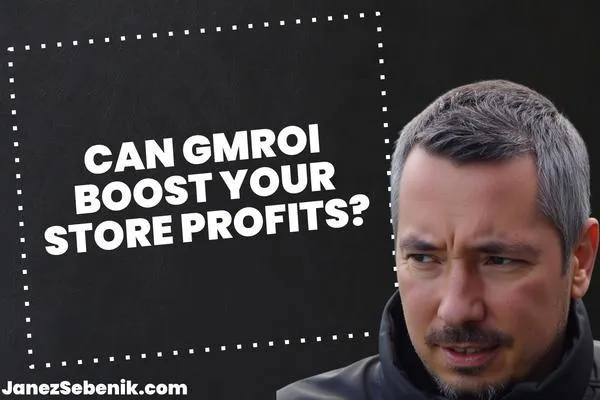
What does GMROI tell you?
GMROI. Sounds fancy, right? It's not just another boring acronym. This little number can make or break your retail business.
Gross Margin Return on Investment (GMROI) shows how much money you're making from the cash you've sunk into your inventory. It's like a report card for your stock. Are you acing the inventory game or flunking out?
Think of GMROI as your retail superpower. It helps you spot which products are secretly superheroes and which ones are just taking up space.
Ready to turn your store into a profit-making machine?
Let's dive into the world of GMROI.
Key Takeaways
GMROI helps you figure out if your inventory is making you money or costing you cash
You can use GMROI to decide which products to keep and which to ditch
Boosting your GMROI can lead to bigger profits and a healthier business
Breaking Down GMROI
GMROI is a powerful tool for measuring retail success. It tells you how well your inventory turns into cash. Let's dive into the key parts that make it tick.
What Is GMROI?
GMROI stands for Gross Margin Return on Investment. It's a fancy way of saying "how much money you make from your stuff."
Think of it like this: You buy a bunch of toys to sell. GMROI tells you if those toys are making you rich or just taking up space.
The formula is simple: GMROI = Gross Margin / Average Inventory Cost.
If your GMROI is $2, that means for every buck you spend on inventory, you're making $2 back. Not too shabby!
Why Gross Margin Matters
Gross margin is the star of the GMROI show. It's what's left after you pay for your products.
Let's say you sell a shirt for $50 that cost you $20. Your gross margin is $30. That's the money you use to pay for everything else - like your fancy espresso machine.
A higher gross margin means more cash in your pocket. It's like finding extra fries at the bottom of the bag. Delicious!
But remember, a high price doesn't always mean a high margin. You gotta find that sweet spot where customers buy and you still make bank.
The Nitty-Gritty of Investment
Investment in GMROI is all about your inventory. It's the cash you've tied up in products.
Think of your inventory like a savings account. You want it to grow, but not just sit there doing nothing.
The trick is to keep your inventory lean. Too much stock? You're wasting money. Too little? You'll miss sales.
Your goal is to turn that inventory into cash faster than a magician pulls rabbits out of hats. The quicker you sell, the higher your GMROI.
Remember, every product on your shelf is money not in your bank account. Make those products work for you!
Calculating GMROI
Ready to crunch some numbers? Let's dive into how you can calculate GMROI and figure out your inventory's performance. It's simpler than you might think.
Crunching Numbers for GMROI
Here's the magic formula: GMROI = Gross Profit / Average Inventory Cost. Easy, right?
First, you need to know your gross profit. That's your sales minus the cost of goods sold (COGS).
For example, if you sold $100,000 worth of stuff and it cost you $60,000 to buy it, your gross profit is $40,000.
Next, divide that by your average inventory cost. We'll get to that in a sec.
So if your average inventory cost was $20,000, your GMROI would be 2. ($40,000 / $20,000 = 2)
That means for every dollar you invested in inventory, you made $2 in gross profit. Not bad!
Understanding Average Inventory Costs
Now, let's talk about that average inventory cost. It's not as scary as it sounds.
Take your inventory cost at the start of the period. Add it to your inventory cost at the end. Then divide by 2. Boom! That's your average.
Let's say you started with $15,000 in inventory and ended with $25,000. Your average would be $20,000. (($15,000 + $25,000) / 2 = $20,000)
Why use an average? It smooths out any weird spikes or dips in your inventory levels.
Remember, lower inventory costs with higher sales is the goal. That'll boost your GMROI and make you smile all the way to the bank.
Applying GMROI in Retail
GMROI helps retailers make smart choices about their inventory. It shows which products are worth keeping and which ones might be costing you money.
Inventory: The Retailer's Dilemma
You've got shelves full of stuff. But is it the right stuff? That's where GMROI comes in handy. It tells you if your inventory investment is paying off.
Think of it like this: You buy a bunch of fancy hats. They look cool, but are they making you money? GMROI gives you the answer.
It's simple math. Take your gross profit, divide it by your average inventory cost. Boom! That's your GMROI.
A high GMROI? You're crushing it. Low GMROI? Time to rethink those fancy hats.
From Shelves to Sales: GMROI's Impact
Now, let's talk about turning those shelf-warmers into cold, hard cash. GMROI isn't just a number. It's your secret weapon for boosting profitability.
You can use GMROI to:
Spot your money-makers
Ditch the duds
Price things right
It's like having a GPS for your store. It shows you where the money is and where it isn't.
High GMROI items? Give them prime shelf space. Low GMROI? Maybe it's time for a clearance sale.
Remember, every product should earn its keep. If it's not pulling its weight, it's just taking up space that could be used for something better.
Balancing Profit and Inventory
GMROI helps you juggle profit and inventory like a pro. It's all about making your money work harder for you. Let's dive into how you can nail this balancing act.
The Art of Pricing
Your prices can make or break your GMROI. Too high, and you're stuck with inventory. Too low, and your profit goes poof.
Gross profit is the star of the show here. It's what you keep after the cost of goods.
Want to boost your GMROI? Try these pricing tricks:
Offer bundles to move slow items
Use dynamic pricing during peak times
Create a loyalty program for repeat buyers
Remember, a small price bump can mean big profits. But don't get greedy. Keep an eye on what your competitors are doing.
Inventory Levels Vs. Cash Flow
Inventory is like a seesaw. Too much, and your cash is tied up. Too little, and you miss sales.
Your inventory turnover rate is key. It tells you how fast you're selling. A higher rate usually means better GMROI.
Here's how to keep your cash flowing:
Use just-in-time ordering
Set par levels for each product
Automate reorders with inventory software
Don't forget about carrying costs. They eat into your profit. Storage, insurance, and damaged goods all add up.
Obsolete Inventory: The Silent Killer
Obsolete inventory is like a leaky faucet. It drains your GMROI drop by drop.
These items take up space and tie up cash. They're the enemies of good inventory turnover.
How to tackle this monster:
Regular stock audits
Clearance sales for aging items
Donate or write off what won't sell
Be ruthless. Every obsolete item is money you can't invest in hot sellers.
Remember, your goal is to keep inventory fresh and moving. That's how you crank up your GMROI and keep the profits rolling in.
Optimizing Business With GMROI
GMROI is your secret weapon for boosting profits. Let's dive into how you can use this metric to supercharge your business.
Segmentation and GMROI
Want to know which products are your real moneymakers? Market segmentation is your best friend.
Break down your inventory by category, brand, or price point.
Then, calculate GMROI for each segment. You'll spot winners and losers fast.
High GMROI items? Stock up and promote them. Low GMROI duds? Time to rethink or ditch them.
This approach helps you focus on what's actually making you money. It's like giving your inventory a report card.
Revising Strategies Mid-Fiscal Year
Don't wait for year-end to make changes. Keep an eye on your GMROI throughout the fiscal year.
Seeing a dip in GMROI? Time to act. Maybe you need to adjust pricing or find a new supplier.
Rising GMROI? Double down on what's working. Increase marketing for those high-performing products.
Remember, GMROI is like a compass. It shows you where to go, even if you're midway through your journey.
Cutting Costs, Not Corners
GMROI isn't just about sales. It's about efficiency too. Look at your business expenses through the GMROI lens.
High employee costs eating into your margins? Train your team to boost sales or streamline operations.
Inventory taking up too much space? Implement just-in-time ordering to reduce storage costs.
Think of GMROI as your business's personal trainer. It helps you trim the fat without losing muscle.
By focusing on GMROI, you're not just cutting costs. You're optimizing every dollar you invest in your business.
Advanced GMROI Insights
GMROI isn't just about numbers. It's about understanding how your inventory makes you money. Let's dive into some advanced ways to use GMROI that'll make your business smarter and more profitable.
GMROI for Luxury Retail: A Different Ball Game
In luxury retail, GMROI works differently. You're not just selling products; you're selling experiences.
Your turnover rate might be slower, but your margins are sky-high.
Think Rolex or Louis Vuitton. They don't need to sell a ton to make bank. Their GMROI can look killer even with lower sales volume.
Why? Because luxury items have insane markups. You might only sell one watch a week, but that single sale could cover your rent for a month.
Here's a quick comparison:
Retail Type Turnover Rate Margin GMROI Fast Fashion High Low Moderate Luxury Low High High
Measuring Inventory Profitability Beyond Ratios
GMROI is great, but it's not the only game in town. You need to look at the bigger picture to really understand your inventory returns.
Think about customer lifetime value. Maybe a product has a low GMROI but brings in customers who buy high-margin items later. That's gold.
Consider seasonal trends too. A swimsuit might have a terrible GMROI in winter, but it's a rockstar in summer.
Don't forget about brand value. Some products might not be profit machines, but they make your store look good. That has value too.
Try tracking GMROI alongside customer satisfaction and repeat purchase rates. You might find surprising connections that'll boost your bottom line.
